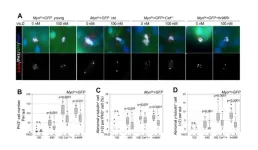(Press-News.org) [Boston, MA—February 27, 2024] Research recently published early online in journals of the American Meteorological Society demonstrates changes at the Earth’s poles, including altered ocean-sea ice dynamics, dampened temperature extremes, and differing responses to solar radiation at the north and south poles, and suggests that long-term warming trends may have played more of a role in 2023’s record-low Southern Ocean ice than previously supposed.
Three papers in the Journal of Climate (JCli) find that the Arctic and Antarctic appear to be adjusting to a warming climate with fundamental changes in regional climate dynamics.
The Antarctic ocean-sea ice system may be fundamentally changing.
A paper by Will Hobbs and colleagues from the Australian Antarctic Program Partnership at the University of Tasmania notes evidence that Antarctic sea ice extent may be exhibiting a “regime shift.” While ice in the Southern Ocean plays a critical role in Antarctic climate—for example, reflecting heat from the sun—the extent of sea ice in summer months has become increasingly variable since 2006, and more closely correlated with the previous month’s sea ice rather than the atmospheric factors that normally drive it. The authors’ statistical analysis suggests that interactions between sea ice and the ocean below may have fundamentally changed (possibly related to global warming), driving this increased variability.
“Perhaps the most striking change for scientists is that … the recent extreme fluctuations over the last decade can’t be explained by the atmosphere alone,” Hobbs said in an AAPP press release. “AAPP research shows that the changes we’re seeing—how much the sea ice can shift from its average state, and how long those shifts can stick around—are controlled by ocean processes. This is more evidence that ocean changes are probably the secret to what’s happened in recent years.”
The Antarctic is absorbing more energy than the Arctic.
Meanwhile, satellite data show differences in how the Arctic and Antarctic are responding to increased temperatures, according to a new paper by Hamish D. Prince and Tristan S. L’Ecuyer at the University of Wisconsin-Madison. Both poles are receiving increased solar energy input, as melting sea ice reduces the regions’ reflectivity. This may affect the temperature gradient between the poles and the temperate regions that drives much of the climate system. This study finds that the warming Arctic is emitting a nearly comparable amount of this increased heat back to space, leaving the region’s net energy imbalance largely unchanged despite rapid ice melt. However, the Antarctic is NOT emitting more heat energy to space, implying that solar radiation is being absorbed into the climate system there in ways that may affect both the Southern Ocean and atmosphere and Earth’s latitudinal heat balance.
“Our study provides a robust, observed record of a fundamental aspect of the climate system. Unlike the Arctic, where increased solar absorption is balanced by thermal emission, the Southern Ocean surface temperature remains insensitive to increasing absorption, accumulating additional energy,” says Prince. “The global impact of this contrasting polar response to reducing albedo may be far reaching but is broadly unknown."
Sea ice melt reduces seasonal Arctic extremes–especially cold extremes.
The third paper is by Igor Polyakov and colleagues from the University of Alaska, Fairbanks. It finds that, as melting sea ice exposes more humid ocean air, the differences between summer high and winter low temperature extremes in the Arctic have been growing smaller since 1979. Across the Arctic, the authors find that average surface air temperatures have increased approximately 0.62°C per decade. While the average has increased, summer hot extremes have become 25% cooler and winter cold extremes have become 200% warmer since 1979—a dampening of extremes that is only expected to continue as the Arctic warms.
"Our study shows a fundamental shift in the Arctic climate system toward increased mobility and a close connection between the atmosphere, ice sheet, and ocean,” says Polyakov. “This strong coupling makes it very difficult to understand the system's behavior, necessitating a multidisciplinary approach in the research of Arctic climate change."
2023’s sea ice low—El Niño? Or no?
Finally, a paper by Till Kuhlbrodt and colleagues in the United Kingdom, published in the Bulletin of the American Meteorological Society (BAMS), suggests that 2023’s record-high North Atlantic sea surface temperature and record low Antarctic sea ice cover extremes were similar to what we might expect to see in a world that had reached the 3°C threshold of global warming. While many factors, including El Niño, have been suggested as the main drivers of last year’s extremes, the authors believe that these explanations may be insufficient. They note that trends of increased radiative forcing have been strong in recent years, and that sea-surface temperature and sea ice extremes were evident 8 to 9 months prior to the strongest effects of El Niño.
Till Kuhlbrodt (University of Reading) says, “Last year’s observed extremes in the North Atlantic and in the Southern Ocean are so concerning because they lie far outside anything we’ve seen in the 40 years before. While the acceleration of global heating will be a major contributor, our analysis of ocean data suggests that a regime change in the oceans could play a crucial role too.”
About AMS Journals
The American Meteorological Society continuously publishes research on climate, weather, and water in its 12 journals. Some AMS journals are open access. Media login credentials are available for subscription journals. Journals include the Bulletin of the American Meteorolocial Society, Weather, Climate, and Society, the Journal of Climate, and Monthly Weather Review.
About the American Meteorological Society
The American Meteorological Society advances the atmospheric and related sciences, technologies, applications, and services for the benefit of society. Founded in 1919, AMS has a membership of around 12,000 professionals, students, and weather enthusiasts. AMS publishes 12 atmospheric and related oceanic and hydrologic science journals; sponsors more than 12 conferences annually; and offers numerous programs and services. Visit us at https://www.ametsoc.org/.
END
Polar climates changing in fundamental ways
New research in journals of the American Meteorological Society suggest altered ocean-sea ice dynamics, dampened temperature extremes, differing responses to solar radiation.
2024-02-27
ELSE PRESS RELEASES FROM THIS DATE:
Remote online genetic education programs can spur testing for inherited susceptibility to cancer, study suggests
2024-02-27
Even as it's become clear that an inherited susceptibility to some cancers is more common than once thought, genetic testing of family members of cancer patients hasn't increased as much as experts had hoped. A new study led by researchers at Dana-Farber Cancer Institute and Brigham and Women’s Hospital demonstrates that a remote online genetic education program can be a powerful motivator for people with a family history of cancer to undertake genetic testing.
The GENetic Education, Risk Assessment, and TEsting (GENERATE) study included 601 people from across 45 states who had a close relative with the most common form of pancreatic cancer. Participants ...
Study shows daylight saving time has minimal effect on heart health
2024-02-27
ROCHESTER, Minn. — A recent Mayo Clinic study examining the effects of daylight saving time (DST) on heart health suggests that the impact is likely minimal.
In the nationwide study, researchers applied an advanced statistical model to look for any connections between DST and serious cardiovascular problems, including heart attacks and strokes. The study looked at 36,116,951 adults aged 18 and up across most U.S. states. (Arizona and Hawaii were excluded since these states do not observe DST.)
Researchers focused on the week directly after the spring and fall DST transition, ...
New disease testing component facilitates lower-cost diagnostics
2024-02-27
A new tool could reduce costs for diagnosing infectious diseases.
Biomedical researchers from The University of Texas at Austin have developed a new, less expensive way to detect nuclease digestion – one of the critical steps in many nucleic acid sensing applications, such as those used to identify COVID-19 and other infectious diseases.
A new study published in the journal Nature Nanotechnology shows that this low-cost tool, called Subak, is effective at telling when nucleic acid cleavage occurs, which happens when an enzyme called nuclease breaks down nucleic acids, such as DNA or RNA, into smaller fragments.
The traditional way of identifying nuclease ...
White House includes two Tufts-related initiatives in commitments to end hunger, reduce diet-related disease
2024-02-27
Two Tufts-related initiatives have been included in the White House’s new round of public and private sector commitments, announced today by the Biden-Harris administration, to end hunger, improve nutrition, and reduce diet-related disease in the United States by 2030. The White House Challenge to End Hunger and Build Healthy Communities continues the Biden-Harris administration’s work started at the historic White House Conference on Hunger, Nutrition, and Health that was held in September 2022, encouraging stakeholders from all corners to develop bold commitments to help achieve the administration’s five key pillars of national ...
U of M-led research identifies predictor of outcomes, chemoresistance for ovarian cancer patients
2024-02-27
MINNEAPOLIS/ST. PAUL (2/27/2024) — In a major scientific breakthrough, newly published research from an international consortium led by the University of Minnesota’s Masonic Cancer Center has the potential to transform the landscape of ovarian cancer treatment.
Published today in JAMA Network Open, the findings indicate that ovarian cancer patients with high levels of stroma within their tumors are twice as likely to exhibit chemoresistance to the conventional standard of care. Stroma is the non-cancerous tissue that provides support to tumors.
The ...
NRG Oncology announces new leadership of Canadian Members Subcommittee
2024-02-27
NRG Oncology, a National Cancer Institute (NCI) National Clinical Trials Network (NCTN) group focused on improving outcomes for adults with cancer through multi-center clinical research, recently announced a new Chair and Vice Chair of the organization’s Canadian Members Subcommittee.
The NRG Canadian Members Subcommittee is tasked with engaging and supporting NRG’s Canadian member institutions through their participation in NRG research. This subcommittee was created to tackle the unique regulatory, administrative, and ...
Bariatric surgery provides long-term blood glucose control, type 2 diabetes remission
2024-02-27
BATON ROUGE – People with type 2 diabetes who underwent bariatric surgery achieved much better long-term blood glucose control compared to people who received medical management plus lifestyle interventions, according to a new study published in JAMA, or Journal of the American Medical Association, and funded by the National institute of Diabetes, Digestive and Kidney Diseases, part of The National Institutes of Health.
In addition, participants who underwent bariatric surgery, also called metabolic or weight-loss surgery, were more likely to stop needing diabetes medications and had higher rates of diabetes remission up to 12 years post-surgery. ...
The anti-aging effect of vitamin D and vitamin D receptor in Drosophila midgut
2024-02-27
“Our study demonstrated that the VitD/VDR [vitamin D/vitamin D receptor] pathway is required for intestinal homeostasis during normal differentiation and aging.”
BUFFALO, NY- February 27, 2024 – A new research paper was published in Aging (listed by MEDLINE/PubMed as "Aging (Albany NY)" and "Aging-US" by Web of Science) Volume 16, Issue 3, entitled, “The anti-aging effect of vitamin D and vitamin D receptor in Drosophila midgut.”
Adult stem cells are pivotal for maintaining tissue homeostasis, and their functional ...
You may be breathing in more tiny nanoparticles from your gas stove than from car exhaust
2024-02-27
WEST LAFAYETTE, Ind. — Cooking on your gas stove can emit more nano-sized particles into the air than vehicles that run on gas or diesel, possibly increasing your risk of developing asthma or other respiratory illnesses, a new Purdue University study has found.
“Combustion remains a source of air pollution across the world, both indoors and outdoors. We found that cooking on your gas stove produces large amounts of small nanoparticles that get into your respiratory system and deposit efficiently,” said Brandon Boor, an associate professor in Purdue’s Lyles School of Civil Engineering, who led this research.
Based on these ...
NREL-led workshop points to path for clean energy future
2024-02-27
Participants in a workshop organized by the U.S. Department of Energy’s National Renewable Energy Laboratory (NREL) agree on the importance of mitigating degradation rates for the continuing rollout of clean technologies.
Renewable energy is forecast to play an expanded role in meeting future needs, with terawatts of electricity expected to be generated from wind and solar, so the performance of the technologies involved is becoming increasingly important. Any technology degrades over time, so researchers are looking at ways to curb this issue. Mitigating degradation will become a factor ...
LAST 30 PRESS RELEASES:
ASH 2025: Antibody therapy eradicates traces of multiple myeloma in preliminary trial
ASH 2025: AI uncovers how DNA architecture failures trigger blood cancer
ASH 2025: New study shows that patients can safely receive stem cell transplants from mismatched, unrelated donors
Protective regimen allows successful stem cell transplant even without close genetic match between donor and recipient
Continuous and fixed-duration treatments result in similar outcomes for CLL
Measurable residual disease shows strong potential as an early indicator of survival in patients with acute myeloid leukemia
Chemotherapy and radiation are comparable as pre-transplant conditioning for patients with b-acute lymphoblastic leukemia who have no measurable residual disease
Roughly one-third of families with children being treated for leukemia struggle to pay living expenses
Quality improvement project results in increased screening and treatment for iron deficiency in pregnancy
IV iron improves survival, increases hemoglobin in hospitalized patients with iron-deficiency anemia and an acute infection
Black patients with acute myeloid leukemia are younger at diagnosis and experience poorer survival outcomes than White patients
Emergency departments fall short on delivering timely treatment for sickle cell pain
Study shows no clear evidence of harm from hydroxyurea use during pregnancy
Long-term outlook is positive for most after hematopoietic cell transplant for sickle cell disease
Study offers real-world data on commercial implementation of gene therapies for sickle cell disease and beta thalassemia
Early results suggest exa-cel gene therapy works well in children
NTIDE: Disability employment holds steady after data hiatus
Social lives of viruses affect antiviral resistance
Dose of psilocybin, dash of rabies point to treatment for depression
Helping health care providers navigate social, political, and legal barriers to patient care
Barrow Neurological Institute, University of Calgary study urges “major change” to migraine treatment in Emergency Departments
Using smartphones to improve disaster search and rescue
Robust new photocatalyst paves the way for cleaner hydrogen peroxide production and greener chemical manufacturing
Ultrafast material captures toxic PFAS at record speed and capacity
Plant phenolic acids supercharge old antibiotics against multidrug resistant E. coli
UNC-Chapel Hill study shows AI can dramatically speed up digitizing natural history collections
OYE Therapeutics closes $5M convertible note round, advancing toward clinical development
Membrane ‘neighborhood’ helps transporter protein regulate cell signaling
Naval aviator turned NPS doctoral student earns national recognition for applied quantum research
Astronomers watch stars explode in real time through new images
[Press-News.org] Polar climates changing in fundamental waysNew research in journals of the American Meteorological Society suggest altered ocean-sea ice dynamics, dampened temperature extremes, differing responses to solar radiation.



